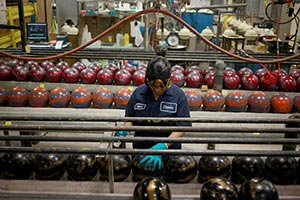Manufacturing Expands at Slowest Pace Since May 2013

Factories expanded in March at the slowest pace since May 2013, a sign struggling overseas economies and cutbacks among oil producers are hindering U.S. manufacturing.
The Institute for Supply Management’s index declined to 51.5 from 52.9 a month earlier, the Tempe, Arizona-based group’s report showed April 1. Readings above 50 indicate growth and the median forecast in a Bloomberg News survey of economists was 52.5.
A measure of U.S. exports contracted for a second month, indicating a stronger dollar is making it difficult for factories to drum up overseas sales. Less investment by America’s energy producers and slower consumer spending so far this year also represent hurdles for domestic manufacturers.
“There is little hope for noticeable momentum in manufacturing activity” in the second quarter, Lindsey Piegza, chief economist at Sterne Agee & Leach Inc. in Chicago, said before the report. “Weak growth and a rapidly rising U.S. dollar” are making goods produced by the world’s largest economy “relatively less attractive to foreign buyers.”
The factory index declined even after the resolution of a work stoppage at West Coast ports that depressed the reading in February. The dispute over a dockworkers’ contract affected supply chains and increased costs, the ISM’s survey showed last month.
Estimates for the ISM factory index from 80 economists in the Bloomberg survey ranged from 49.5 to 55.
The ISM’s gauge of new orders declined to 51.8 last month, the weakest since May 2013, from 52.5 in February. Order backlogs dropped to 49.5 from 51.5.
The measure of export orders dropped to 47.5 in March from 48.5. The ISM’s U.S. factory employment index declined to 50, the also the lowest since May 2013, from 51.4 the prior month. The production measure was little changed at 53.8 after 53.7 in February.
The report also showed the gauge of factory inventories dropped to 51.5 in March from 52.5. An index of prices paid rose.
A slowdown in exports and depressed commodity prices are straining some companies such as U.S. Steel Corp. The nation’s second-largest steelmaker said in a statement March 31 that it will temporarily idle some capacity at a Minnesota iron-ore plant, effective June 1.
“Global influences in the market, including a high level of imports, unfairly traded products and reduced steel prices, continue to have an impact,” the company said.
Foreign exchange rates are also making it tougher for manufacturers as a rally in the dollar makes U.S. goods more expensive for overseas customers. The greenback has climbed almost 25% since June 30.
Oil prices that have slumped about 55% since the end of June are taking a toll on equipment manufacturers as well, reducing orders. The number of rigs targeting oil in the U.S. has dropped 49% since the end of October.
Factories are also struggling with lackluster consumer demand as well, though a pickup in sentiment and employment gains may allow manufacturing to stabilize.
Household purchases barely rose in February, a report from the Commerce Department showed March 30. The 0.1% gain followed a 0.2% drop in January. Adjusting for changes in prices, spending dropped for the first time in almost a year.
A report March 31 from the Conference Board showed consumer confidence climbed to 101.3, the second-highest reading of the current economic expansion, from 98.8 in February. The rebound bolsters forecasts that spending, which accounts for almost 70% of the economy, will strengthen.
Americans were more upbeat about job and income prospects, and a report later this week is projected to show payrolls increased by almost a quarter million in March.
Cheaper fuel prices have also given households the wherewithal to boost spending. A gallon of regular unleaded gasoline cost an average $2.41 on March 31, down from last year’s peak of $3.70, according to U.S. motoring group AAA.




